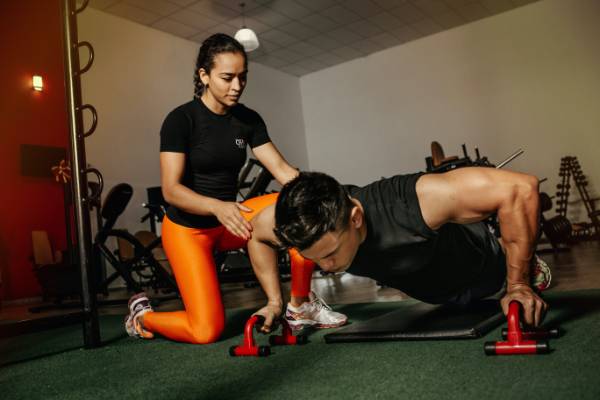When bench pressing, what position should the wrists be in? The hands, wrist, and forearm should all be lined up, and the barbell’s weight should be stacked over the wrists. Please read on and learn how to put your wrist in the correct position while you are bench pressing.
5 Rules For Wrist Positions For Bench Pressing
Choose An Appropriate Grip Width
The width at which we can maintain an effective force transfer into the barbell with a neutral wrist is the appropriate grip width. When the barbell is on the chest, this position usually has the hands slightly wider than shoulder-width apart and the elbows slightly in front of the bar.
The chest muscles must work harder when holding a grip that is too wide. The transmission of force from the body to the bar will be reduced when the forearms, hands, and wrists are not in line (which they wouldn’t be with a wider grip), so lifters will probably not be at their strongest in a position that is too wide.
Place The Bar In The Palm Of The Hand
In order to perform the bench press, we want the bar to rest at the base of the hand, which is also known as the “meaty” part of your hand. The reason for this is that we are better able to maintain the load stacked over the wrist joint when the bar rests toward the base of the hand (as opposed to in the fingers).
The barbell is held in this preferred position in the hand because keeping the load stacked over the joint lessens the stress on the wrist.
It is more likely that the load will bend the wrist back if it is held in the fingers rather than over the wrist, which could lead to wrist pain over time and reduce the amount of force that is transferred from our body to the bar.

Use A Full Grip On The Barbell
Always bench with a full grip on the barbell—four fingers over the bar and the thumb under the bar—as recommended. By assisting in maintaining a more neutral position of the wrist, this full grip on the barbell helps with the transmission of force through the wrist.
Additionally, because it is the safest grip to use when performing the bench press, it is preferred.
The suicide grip also referred to as the thumbless grip, places the thumb next to the index finger rather than underneath the barbell and is not advised for those who want to compete in powerlifting.
Keep The Wrist In Line With The Hand
When we hold the bar in our hands, we must prevent our hands from bending to the left (ulnar deviation) or to the right (radial deviation). This is accomplished by keeping the wrist in line with the hand.
Maintaining alignment between the hands and wrists will help us apply our body weight to the bar more effectively and put less stress on the joints. In order to accomplish this, stack the hands, wrists, and forearms together.
Maintain A More Neutral Wrist Position
We are better able to maintain a more neutral wrist position when the bar is placed in the palm of the hand; a neutral wrist is one that is neither bent backward nor flexed forwards.
By being able to transfer force from the upper body to the bar more efficiently by keeping the wrist in a more neutral position during the bench press, we can press more weight. This reduces the strain on the wrist as the load on the bar increases.
The wrists may occasionally bend back slightly (into wrist extension), but as long as the bar is still stacked over the wrist joint, this is usually not a problem.
Bench Press And Wrist
Start position
- Lie down on the bench with your eyes looking straight up and your feet flat on the ground
- For maximum power transmission up the arms and to the bar, the bar should rest on the heel of your palm (not up near the fingers) and directly over (aligned with) your forearm. This will prevent power from being focused through the wrists and instead allow it to go directly to the bar.
- After properly positioning the bar on the heels of your hands, wrap all of your fingers around it.
- Grasp the bar with the wrists directly under the bar approximately shoulder width (or slightly wider than shoulder width) apart – we’ll talk about grip width later on
- Touch your shoulder blades together in the back
Lowering phase
- Unrack the bar
- With elbows and wrists locked, move the bar out to get the bar over your chest
- Lower the bar to your chest
- The bar will contact your sternum (the bone in the middle of your chest, between your pecs) a few inches below your collarbone
Lifting phase
- Touch the chest with the bar, and then drive the bar right back to exactly the same position with your elbows and wrists locked
End position
- Rack the bar (with the help of a spotter if you have one) back to the start position
What Should You Do When Your Wrists Hurts While Bench Pressing
Identify Whether You Have Any Loss Of Sensation
As soon as your wrist begins to hurt, be sure to: haven’t lost any sensation (loss of physical feeling) in your wrist or hand, don’t have any new weakness in the wrist (especially grip strength), and go directly to be evaluated in person if your wrist pain doesn’t follow the rule of twos.
Assess Using The Rule Of Twos
The rule of two states that you should first rate your wrist pain on a scale of zero to ten (zero being no pain and ten being the worst pain possible), and that you should then monitor the pain level in your wrist as you exercise or continue to bench press.
For example, if your wrist pain from bench pressing increases by two levels (on a scale from one to ten on the pain scale) for longer than two hours, you are doing too much and should either scale back your efforts or get a physical examination from a doctor.
Use “Price”
The acronym RICE, which stands for rest, ice, compress, and elevate, will be familiar to anyone who has taken a first aid course. We are merely enhancing the acronym with PRICE by introducing protection.
A compression wrap or brace can be used as protection for the wrist to reduce swelling and add support. Sometimes you’ll use protection before seeing a doctor to make sure the wrist doesn’t get hurt again (accidentally) and get worse.
Decrease Inflammation
One of the most effective, affordable (often free), and traditional anti-inflammatories available is ice. To prevent skin damage, the general rule for applying ice is five minutes on, ten minutes off.
With the help of your doctor, you can reduce inflammation if ice isn’t doing the trick by taking oral medications or even applying a topical anti-inflammatory.
Prior to beginning any exercises or rehabilitation after an acute injury, inflammation should be under control because you don’t want to start irritating a painful body part. This will only worsen the situation by causing more inflammation, which is what causes the pain.
Use Training Modifications
Bench pressing should be avoided while your wrist pain is being treated if it hurts while you are doing it. It’s generally a good idea to stay away from activities that could aggravate your wrist pain in order to keep things from getting worse.
When engaging in activities while experiencing wrist pain, it’s a good idea to follow the previously mentioned rule of twos.
Read More: Why Does My Elbow Hurt After Benching? Reasons & Solutions
